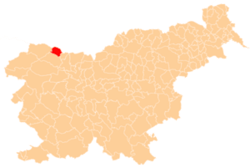Karawanks Tunnel (motorway)
 Northern entrance, Austria | |
| Overview | |
|---|---|
| Location | Sankt Jakob im Rosental, Carinthia, Austria / Hrušica, Municipality of Jesenice, Slovenia |
| Coordinates | 46°31′09″N 14°01′22″E / 46.51917°N 14.02278°ECoordinates: 46°31′09″N 14°01′22″E / 46.51917°N 14.02278°E |
| Route | Karawanken Autobahn / A2 motorway |
| Operation | |
| Work begun | 1986 |
| Opened | 1991 |
| Operator | Autobahnen- und Schnellstraßen- Finanzierungs- Aktiengesellschaft (ASFiNAG) |
| Character | Single-tube |
| Technical | |
| Length | 7,864 m (25,801 ft) |
| Number of lanes | 2 |
| Operating speed | 80 km/h (50 mph) |
The Karawanks Tunnel (German: Karawankentunnel, Slovene: Predor Karavanke or Karavanški predor) is a motorway tunnel crossing the Alpine Karawanks mountain range between Austria and Slovenia, with a total length of 7,864 m (25,801 ft) (4.89 miles), 8,019 m (26,309 ft) (4.98 miles) enclosure between the portals. Its construction began in 1986 and it opened on June 1, 1991. It connects the Austrian Karawanken Autobahn (A11) from Villach with the A2 motorway leading to Kranj and Ljubljana in Slovenia, decongesting the historic Loibl/Ljubelj and Wurzen/Korensko sedlo mountain passes.

In the late 1970s it was planned as a two-tube tunnel, (one two-lane tube for each direction), but lower than expected levels of traffic have meant that it has remained a single tube, single lane, two-way tunnel. The tunnel was built between 1986 and 1991 by the Tauern Autobahn stock company at the behest of the Federal Republic of Austria, represented by the State of Carinthia. At its opening it was one of the best equipped tunnels with safety and surveillance systems: emergency phones, fire detectors, video surveillance, traffic signalling, radio and phone connections, air circulation monitoring and carbon monoxide sensors.
Less than a month after its opening, in late June 1991, the Slovene terminus of the tunnel and its border post at Jesenice were briefly seized by an armored detachment of the Yugoslav People's Army during the Ten-Day War. The site witnessed brief but intense fighting, which included the ferrying of reinforcements to the Yugoslav troops by helicopter and culminated in an ineffectual airstrike by the Yugoslav air force. The border checkpoint building was heavily damaged in the crossfire.
Driving on Austrian as well as on Slovenian motorways requires a toll sticker. However, driving through the tunnel doesn't require the austrian one.[1] Instead, a special toll (2016 rate) of 7.20 euros[2] (20% VAT included) is imposed on drivers of vehicles up to 3.5 tons for using the tunnel. The toll is collected for the section from the closest on-ramp to the tunnel on the Austrian side to the Austrian/Slovenian border in the middle of the tunnel.[2]
Vehicles over 3.5t (trucks, buses, motorhomes) pay toll on Austrian highways based on number of kilometres travelled. For the 10 km section that includes the tunnel a special rate 8.6 times higher than normal one is applied, coming to 16.27-46.36 € incl.VAT (13.56-38.63 € + 20% VAT)[3] depending on number of axles and engine emission standard.
Since Slovenia has joined the Schengen Area by the end of 2007, border controls have been abolished. Due to increasing traffic volume especially after the completion of the second tube of the Tauern Road Tunnel in June 2011, congestions crop up, especially on weekends, in the summer season and have led to the resumption of plans to build a second tube. The contract for the second twin tunnel was signed in September 2015, with a expected completion date of 2023.
See also
External links
- Karavanški predor/Karavanke Tunnel. TV-news coverage of the beginning of the construction of the tunnel. August 1986. RTVSLO.
- Karawanks Tunnel. Information about Karawanks Tunnel with Autobahn Webcam
- Karawanks Tunnel. More Information about Karawanks Tunnel (German)
References
- ↑ "Tarife Sondermaut 2016" (in German). ASFiNAG. Retrieved 30 September 2016.
Auf den Sondermautstrecken gibt es keine Vignettenpflicht
- 1 2 "Special toll rates 2016". ASFiNAG. Retrieved 30 September 2016.
The special toll route is between the St. Jakob im Rosental junction and the national border in the Karawanken Tunnel (Rosenbach toll station)
- ↑ "Toll rates 2016". ASFiNAG. Retrieved 2016-09-30.
